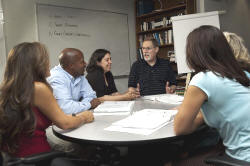CELTA written assignment: lessons from the classroom

The purpose of the assignment
The CELTA handbook explains that this assignment allows you to demonstrate that you can:
- note your own teaching strengths and weaknesses in different situations in light of feedback from learners, teachers and teacher educators
- identify which ELT areas of knowledge and skills you need further development in
- describe in a specific way how you might develop your ELT knowledge and skills beyond the course
- use written language that is clear, accurate and appropriate to the task
 |
The structure of the assignment: reflecting and evaluating your teaching |
Your centre will probably give you a set of instructions for your
assignments. You'd be foolish to ignore these.
What follows is generic advice.
In this assignment, you are pretty much on your own in terms of
content but the structure is predictable from its purposes (above).
This assignment has two main
parts. You do not need an introduction because it is clear
what it is about.
 |
Identifying the strengths and weaknesses |
- The first thing to do is to look back
over your feedback from tutors, students and fellow
participants. From that you need to identify strengths and
weaknesses and categorise them in some way. Here are some
suggestions:
- Planning and preparation.
Think about:
Did you choose suitable material?
Was your planned timing accurate?
Was the lesson structure coherent and appropriate? - Presenting language and skills:
Were you clear?
Did you do the analysis before the lesson?
Did you explain clearly and accurately?
Did you focus on pronunciation adequately? - Providing practice:
Was there enough of it?
Did it work?
Did the learners get to use language relevant to them?
Was the level of challenge right?
How are your drilling skills? - Classroom management:
Were your instructions clear?
Did you organise the room appropriately?
Did you group learners well and re-group them unfussily? - Handling error:
Did you intervene at the right times?
Did you explain why something was wrong?
Did you give the learners the opportunity to correct themselves and each other? - Developing skills:
Did you teach skills as well as practising them?
Do you understand the nature of skills work in all 4 areas?
Can you list three subskills in each of the four areas? - Developing language systems
knowledge:
Do you have a firm enough grasp of the grammar of English?
Can you explain grammatical points clearly and simply?
Can you define words unambiguously?
Can you transcribe phonemically?
Do you understand discourse?
- Planning and preparation.
Think about:
If you would like to have that list as a form
for you to fill out,
it's available here. The form has extra spaces for you to
add areas of concern.
The form also has 4 numbers at the end for you to list the
priorities for action. After you've filled in the form, look through
it to identify what they should be. Anything with a tick in the
Not usually and Never columns is
a suitable candidate.
 |
Taking action |
Now you need an Action Plan.
They usually come in four
parts and can be helpful presented as a table, like this:
| Priority | Reason | Action | Evaluation |
| My instructional language is often too lengthy and unclear | Unclear instructions lead to wasted classroom time and decrease the sense of orderliness and purposefulness in the classroom |
|
|
| I don't handle error well | If learners are not guided by a focus on key errors, learning and development is inhibited |
|
|
| and so on |
Notice that
- The first column states the problem
- The second column explains what effect on learning the weakness has (i.e., why it is important)
- The third column says what you will do
- The fourth column explains how you will measure the outcomes and see any improvement.
There is an important distinction between columns three and four. There is little point in taking action if you have no way of measuring whether it is effective.
There is an entire section of this site devoted to teacher development. Go there for more ideas.
| the CELTA index |
